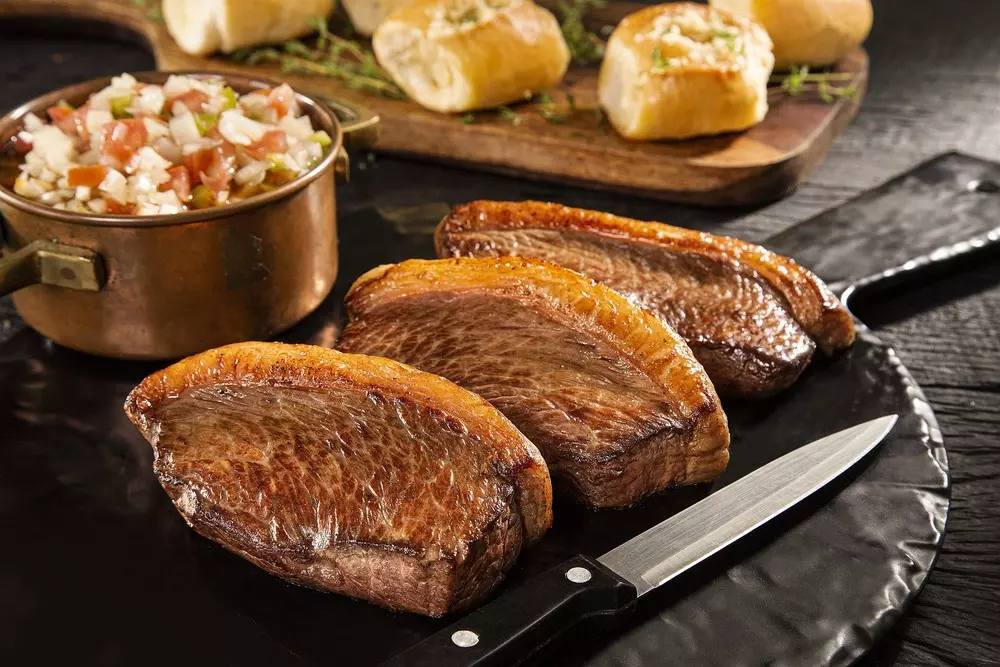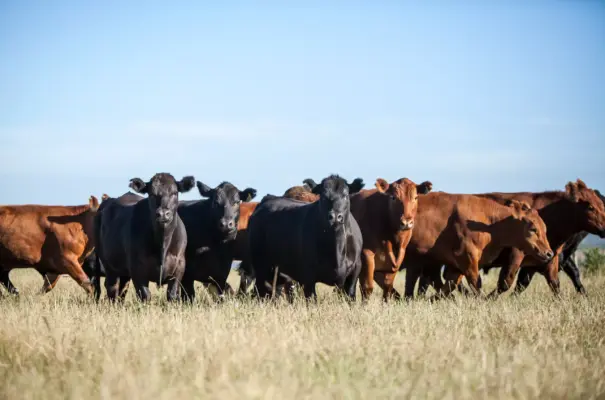Throughout Brazil, Gaúcho barbecue is synonymous with quality. Its fame crosses borders and has even become an attribute for steakhouse brands across the country. But this reputation is not by chance. It begins in the field, based on safety and innovation, and even has a record: since 2006, Carne do Pampa Gaúcho has been the only geographical indication for beef on the entire American continent and one of the first three Brazilian Indications of Origin (IG200501) in any sector, according to the Brazilian Agricultural Research Corporation (Embrapa), making Rio Grande do Sul a pioneer in valuing products of controlled origin. The seal, granted by the National Institute of Industrial Property (INPI) to products or services whose reputation is directly linked to their place of origin, officially recognizes that the product’s characteristics—such as flavor, tenderness, and breeding system—are associated with the territory of the Gaúcho Campaign, where extensive cattle farming on natural pastures has been traditional for centuries. This recognition strengthens the reputation of Gaúcho beef in domestic and international markets, functioning as a competitive differentiator similar to what happens with wines from regions like Bordeaux, France, or Parma ham, in Italy.
This prestige gained even more strength in May 2025, when Brazil achieved the status of a country free from foot-and-mouth disease without vaccination, granted by the World Organisation for Animal Health (WOAH/OMSA) during its annual assembly in Paris. The recognition paved the way to accelerate negotiations with demanding markets, such as Japan. Due to its consolidated sanitary trajectory, the Southern region has been prioritized in negotiations, according to a report published by Reuters, with a focus on Rio Grande do Sul, as well as Paraná and Santa Catarina.
As part of this process, from June 9 to 13, a mission from Japan’s Ministry of Agriculture, Forestry and Fisheries (MAFF) audited the structure of the Official Veterinary Service (SVO) in Brazil. In Santa Catarina, auditors visited the Local Veterinary Unit (UVL) in Biguaçu, a control reference that already guarantees pork exports to Japan. In Paraná, they inspected SVO units in Cascavel and the headquarters of the Paraná Agricultural Defense Agency (ADAPAR). In Rio Grande do Sul, they monitored the activities of the International Agricultural Surveillance System (Vigiagro), linked to the Secretariat of Agricultural Defense (SDA), in Uruguaiana, and learned about the Sentinela Program, an initiative by the Secretariat of Agriculture, Livestock, Sustainable Production, and Irrigation (Seapi-RS) that strengthens active surveillance at borders and monitors potential sanitary risks. The agenda also included the presentation of pilot projects for cattle traceability launched during Expointer—the largest open-air agricultural fair in Latin America.
The fair also served as the stage for another significant announcement: the entry of Minerva Foods, one of the largest beef exporters in Latin America, into this market. The company presented advancements in traceability, animal welfare, and low-carbon certifications, aligning Gaúcho cattle farming with global trends in responsible consumption. “In 2024, we took an important step by acquiring new industrial plants in Alegrete, Bagé, and São Gabriel, consolidating our presence in Rio Grande do Sul, a state with a century-old tradition in cattle farming and which offers ideal conditions for producing high-quality meat, by combining mild climate, consolidated genetics, efficient management, and ranchers deeply connected to the land,” stated Minerva Foods’ Cattle Buying Director for Latam, Fabiano Ribeiro Tito Rosa.
According to him, “Minerva Foods’ arrival in the Gaúcho market represents not only a strategic expansion move but also an opportunity to strengthen partnerships with local producers and further enhance the value of southern beef. Rio Grande do Sul plays a historic and relevant role in building the image of premium Brazilian beef, and our presence in the state is also a recognition of this vocation.” In September of this year, the Bagé and Alegrete units were authorized by the Ministry of Agriculture and Livestock (MAPA) to export beef to Indonesia.
Quality that comes from DNA

Genetics is another differentiator. As Tito explains, the state is recognized for its strong production of taurine breeds, which are more commonly used in premium production. To give an idea of the importance of this market, in the first semester of 2025 alone, the export of Certified Angus Beef reached a new record, with an increase of 98.6% compared to the same period of the previous year. In total, 2,648 tons were exported. Israel stood out as the main buyer, responsible for 35% of sales, surpassing China, which accounted for 31% of shipments, according to the report released by the Brazilian Angus and Ultrablack Association.
The birthplace of the Hereford and Braford breeds, Rio Grande do Sul leads improvement programs such as PampaPlus. At Expointer 2025, Embrapa Pecuária Sul and the Brazilian Hereford and Braford Association (ABHB), in partnership with BioData Data Science, launched the Real Carcass Index (IRC), capable of predicting bulls with greater potential to generate premium beef offspring. The technology measures marbling, finish, and yield of noble cuts, meeting the bonuses of the meat industry and expanding profitability throughout the chain.
The sector’s strength is also reflected in the economy. Agribusiness accounts for about 40% of Rio Grande do Sul’s GDP in 2025, according to the 2025 Radiography of Gaúcho Agriculture. In 2024, the state’s GDP grew by 4.9%, driven primarily by extensive cattle farming on the natural pastures of the Campanha region, a model valued for its low input use and animal welfare.
The challenge now is to increasingly align tradition and innovation with the sustainability agenda. The ABC+ Plan foresees the expansion of low-carbon agriculture in Rio Grande do Sul to 4.6 million hectares by 2030, including the recovery of 1.43 million hectares of pastures and the implementation of 1 million hectares in integrated systems. During the 47th Expointer, held last year, the state coordinator of ABC+RS, Jackson Brilhante, outlined the goals agreed upon by the State Management Committee of the Plan, based on the Decarbonization and Sustainability Policy sanctioned in 2023 by the State Government:
- Expand 600,000 hectares with no-till farming systems;
- One million hectares for the use of bio-inputs;
- Have 200,000 cattle in intensive finishing systems. In December 2024, the announced expectation is to reach 209,000;
- Expand planted forest areas by 322,000 hectares;
- Increase irrigated areas by 216,000 hectares (55% of the target had been reached, according to information broadcast in December 2024 on Canal do Boi);
- Reach 11.8 million cubic meters of animal waste management.
“In two years, we have had an increase of 80,000 hectares of irrigated area, which corresponds to 40% of the target,” he said, as shown in a report published on the specialized portal Agrolink. Furthermore, according to the Rural Technical Assistance and Extension Company of Rio Grande do Sul and the Southern Association of Credit and Rural Assistance (Emater/RS-Ascar), more than 80,000 producers have been reached by actions and training related to the program.
In a meeting with researcher Martial Bernoux, representative of the Office of Climate Change, Biodiversity and Environment (OCB) of the Food and Agriculture Organization of the United Nations (FAO), in June of this year, the head of the Secretariat of Environment and Infrastructure (Sema), Marjorie Kauffmann, detailed the good practices implemented, highlighting the development of an inventory of greenhouse gas emissions and specific studies for the Pampa biome.
Among the practical effects, reductions of nearly 50% in methane emissions have already been observed in areas with crop rotation, and significant gains in livestock farming on properties that have adopted animal load and pasture height management. In a report published on the state’s official website, she states that “scientific evidence not only validates sustainable practices in the field but also contributes to the development of a State database. These proposals will also be presented at the 30th United Nations Climate Change Conference [COP30], promoting sustainable agriculture—which ensures productivity, food security, and climate resilience simultaneously.”
With international sanitary recognition, excellent genetics, pioneering certifications, and the strength of partnerships like that of Minerva Foods, Gaúcho beef is projected as a natural candidate to serve increasingly selective markets. A trajectory where tradition and innovation go hand in hand, reinforcing the foundation that makes Gaúcho barbecue a symbol of quality in Brazil and worldwide.
Reference sources:
- Brazil, Japan beef talks focus on smaller Brazilian states, upsetting industry
- Carne consciente: o que você precisa saber sobre bem-estar animal
- Em novo recorde, exportação de carne Angus Certificada cresce 98,6% no primeiro semestre de 2025
- Estudo aponta que agronegócio é responsável por cerca de 40% do PIB estadual
- Expointer
- FICHA TÉCNICA DE REGISTRO DE INDICAÇÃO GEOGRÁFICA
- Governo apresenta ações pelo clima à Organização das Nações Unidas para a Alimentação e a Agricultura
- Meta de irrigação do Plano ABC+RS já chega a mais de 50% a seis anos do prazo final
- O que define um churrasco perfeito?
- Plano ABC+ apresenta ações promovidas no RS durante a Expointer
- Plano ABC+ apresenta ações promovidas no RS durante a Expointer
- Plano ABC+RS
- Tecnologia é capaz de prever rebanhos bovinos com carne de alta qualidade




